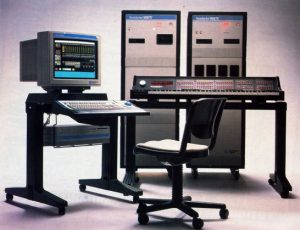Michael Jackson used the Australian Fairlight Computer Music Instrument (CMI), which was a state-of-the-art digital synthesizer and workstation. The Fairlight consisted of a large Central Processing Unit (CPU) with two microprocessors and two 8” floppy disk drives, a QWERTY keyboard with a monitor, and two six-octave keyboards (Harkins 2015). This system was high end and expensive at the time and was not widely available for consumer use, but primarily used by producers. The system could generate musical sounds through analog/digital synthesis and gave its owner the ability to sample pre-existing sounds into digital memory, process them, and play them back through a keyboard (Harkins 2015).

At the same time that the Fairlight CMI was being developed, Roger Linn was working on the LM-1 Drum Computer in Los, Angeles that could use pre-recorded digital samples to replicate the sounds of an acoustic drum kit (Fulton, 28). The ability to synthesize these drum sounds became a huge part of popular music, and are highly prominent in Jackson’s Bad album. In 1980, New England Digital released the Synclavier II, which offered users a 16 track digital memory recorder (Harkins 2015). Jackson also used the Synclavier PSMT, a later version of the Synclavier II to produce Bad. With the combination of the Fairlight CMI and Synclavier PSMT, Jackson paired up with Quincy Jones and Chris Currell where they thrived using the digital sampling technology to create and mix new, unheard before sounds.
